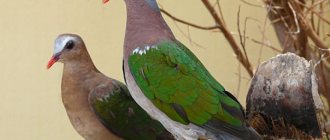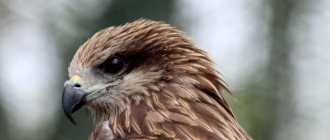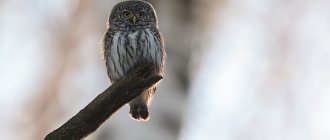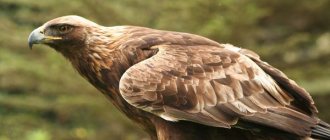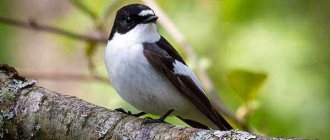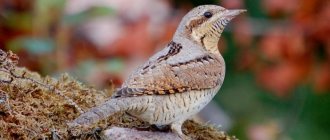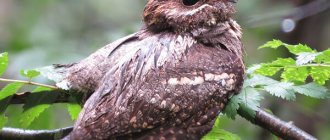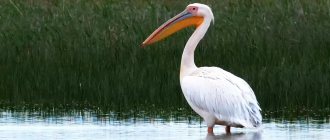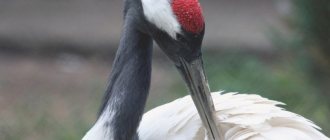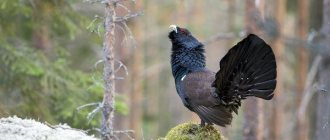| Latin name | Anser erythropus |
| English name | Lesser white-fronted goose |
| Squad | Anseriformes |
| Family | Duck |
| Body length, cm | 52-64 |
| Wingspan, cm | 121-130 |
| Body weight, kg | 1,5-2,4 |
| Features | The species is similar to the white-fronted feathered representative, but differs in smaller stature and a short beak. In adults, there is a light spot on the forehead that reaches the top of the head. |
| Number | 26-30 thousand |
| Security status | Vulnerable (declining) |
| Habitats | Swamps, prairies, fields, lakes, bays, tundra. |
| Additionally | There are four subpopulations of the species: 1) Fennoscandian, 2) Western, 3) Eastern, 4) individuals raised in captivity in Sweden. |
- 2.1 Range
Description
The lesser white-fronted goose, Anser erythropus, is one of the most endangered species. A significant negative factor for poultry is the high mortality rate from poaching. The loss of the lesser white-fronted white-fronted habitat also has a negative impact.
Number
— Advertising —
According to scientific data, at the end of the 20th century, the population size of the species was about 30,000-50,000 individuals. Today, the number of adult lesser white-fronted lessers is estimated at 26,000-30,000.
Structure and dimensions
The Lesser Lesser Bird has brown plumage on the head, neck and upper body, generally darker than that of the greater goose. The species also has longer wings that extend beyond the tip of the tail when closed.
The lesser white-fronted goose has a smaller body weight, a shorter and brighter pink beak, and a more rounded head compared to the large goose. There is a bright yellow ring around the eyes. Adults have a white line on the face that ends above the eye. Like the large type, the legs are pinkish. Both genders are similar.
— Advertising —
The description of a baby lesser lesser bird says that its body is brown, but darker than that of an adult bird.
The body length of the feathered representative is from 52 to 64 cm, the wingspan is from 121 to 130 cm. The average weight is 1.5-2.4 kg.
Interesting facts about the animal
The white-breasted goose adapts well in captivity. If an individual is raised among domestic geese, it quickly forgets about its origin and can find a mate among poultry. The enclosure will become her home.
The Lesser Lesser Goose has a unique voice. During the flight it squeaks. No other creature can make such sounds. Thanks to this feature, the goose received the name lesser white-fronted goose.
Parents don't just care for their chicks. They are constantly engaged in learning. Young geese grow and develop quickly. Already at three months they are full-fledged birds.
Do you have any questions about Goose Little Pisces or something to add? Then write to us about it in the comments, this will make the material more useful, complete and accurate.
Habitat
The bird prefers to nest in river valleys near low mountains, forest-tundra and southern tundra. There the species lives in areas near both large rivers and small streams, settling in areas of forest vegetation.
Area
Lesser white-fronted goose is found in more than 20 countries that are part of the European Union. The bird nests in the northern part of Eurasia on the border with the tundra, in the northern taiga and forest-tundra.
Fennoscandian individuals live in the east of the Bolshezemelskaya tundra, as well as in Western Siberia, which are located in the Russian Federation.
Relationships with a person
Factors influencing the decline in the number of the species are hunting in the wintering areas of geese, as well as frequent poisoning of birds with chemicals.
One of the common limiting factors is the destruction of habitual habitats: draining water bodies, cutting down bushes.
This species is protected by humans. Lesser white-fronted geese are bred at the Moscow Zoo and in the reserve on the Kanin Peninsula in the Nenets Autonomous Okrug.
If you found this article helpful, please share it on social networks. Leave comments, like - help preserve the population of rare and scarce geese.
Nutrition
The main sources of food for poultry are plant products. In winter, the species feeds on seeds and grain residues in the fields. In summer - stems, roots of grasses, sedges, horsetail, other plants, as well as berries and buds. The bird eats some aquatic insects and sometimes snails, which it accidentally swallows along with plants.
Lesser Lesser Lesser Feeding
Despite the fact that the Lesser Lesser Lesser White-fronted Goose spends most of the day in the water, it finds food for itself exclusively on land. Twice a day, morning and evening, the school gets out of the water in search of shoots of young grass, leaves, clover and alfalfa. Her diet contains food exclusively of plant origin.
Rotten fruits and mulberries are considered a very great delicacy for the Lesser White-fronted White-fronted. They can also often be seen near fields with legumes or grain crops.
Reproduction
The nest is built by the female and filled with down from her body. The girl lays one egg every day until she has a clutch of about 5 eggs. After the eggs are laid, the female sits in the nest and incubates them. This process takes about 28-30 days.
Whenever the female leaves the nest, she covers the eggs with sticks to keep the offspring warm and camouflaged. During this, the male stands nearby and watches for predators and enemies.
Character and lifestyle
The Lesser Lesser Goose is a very cautious bird, especially when it is in a flock. But when females incubate eggs and hatch offspring, their caution disappears, and they can allow them to get very close to them. Birds fly quite quickly, although from the outside their flight may seem slow. During migration to warm regions, gray geese fly at high altitudes.
During such flights, they move primarily in a wavy line or V-shaped wedge. They have a firm and confident gait along the earth's surface. In addition, lesser white-fronted white-fronted animals can run quickly and agilely. They often prefer to stand on one limb. This is a flocking bird. But during breeding periods, it prefers solitude with its mate and nests separately.
Chicks
The young begin to walk and swim soon after hatching. Both parents typically bring the young to feeding areas. There the kids get their own food.
The age of the first flight is 38-45 days. The young remain with their parents for the first year of life and are often associated with them for several years.
Lesser Lesser Lesser Lesser Lesser Lesser Lesser Lesser Lesser Lesser Lesser Lesser
The lesser white-fronted goose is the smallest goose in our country. The weight of the largest birds does not exceed 2.7 kg, and the wingspan is 135 cm. Such a miniature goose has a corresponding voice, not a solid cackle, but squeaky and even shrill sounds “gin-gin”, “gi-vi-vi”. It was they who allowed hunters to give this bird such an apt name.
Where does he live?
Lesser white-fronted ducks nest in the mountainous northern taiga, inhabiting the forest-tundra and southern tundra of Eurasia. The species was introduced into Scandinavia. However, today they are distributed very unevenly, their range is discontinuous. In Russia, birds are found in the territory from the Kola Peninsula to the Gulf of Anadyr.
The Lesser Lesser White-fronted Lesser White-fronted Lesser White-fronted White-fronted is a typical inhabitant of the river valleys of the northern taiga lowlands, forest-tundra and southern tundra, where it inhabits the valleys of both the largest rivers and small streams and settles mainly at the border of forest vegetation.
These birds winter in the Caspian Sea, the Black Sea region, the south of Western Europe, Asia Minor, the countries of Southeast Asia, the Balkans, Azerbaijan and China.
External signs
The weight of lesser white-fronted geese ranges from 1.5 to 2.5 kg; these are relatively small geese. The total length reaches 66 cm, the wingspan is 135 cm.
The main color of the outfit of these birds is brownish-gray, but the belly and undertail remain snow-white. The most characteristic external feature of the lesser white lesser is the white spot on the head that reaches eye level. And their eyes are surrounded by lemon-yellow rings, similar to glasses, which stand out against the background of the main gray plumage. The legs, like those of most geese, are orange-red. The beak is pink and short. Young birds that have not reached sexual maturity do not have the distinctive mark of the lesser white lesser - a white spot.
The eyes of the lesser white lesser are framed by a thin yellow ring.
The downy chick is dark brown on top, the forehead is greenish-yellow, a longitudinal dark stripe runs through the eye, and the underside of the body is yellowish.
Lifestyle
Lesser white-fronted gooses make nests on the islands of lakes, only to spend a short three months here and then go on a long journey. Flights take up almost half of their lives, and the total distance they cover during the year is about 8,000 km. Moreover, each journey covers a distance of approximately 1500 km. Between such flights, the lesser lesser white-fronted goose makes long stops to recuperate and continue on its way.
Lesser white-fronted gooses usually fly in random flocks; only during long flights do they form an oblique line or an angle. This bird not only walks deftly on the ground, but also runs nimbly. Moulting geese, incapable of flight, seeing a person from a distance, try to get ashore and hide in the thickets. They do this so quickly and successfully that it is almost impossible to detect them there.
A pair of little lessers
The lesser white-fronted goose, like other geese, feeds mainly on plant foods - horsetails, cotton grass, cereals, other herbs, as well as fruits and seeds. It is interesting that lesser white-fronted white-fronted lilies obtain their food exclusively on land. During wintering, this miniature goose grazes in winter crop fields, eating barley and alfalfa.
They can dive and swim with only their heads out of the water.
Reproduction
During nesting, this small goose forms rare colonies and willingly settles under the protection of feathered predators - rough-legged buzzards and peregrine falcons.
The sedentary life of lesser white-fronted goose in Russia begins in May - June, from the moment they arrive at the nesting sites. They make nests in rocky ledges hidden under bushes. The homes of these geese are arranged quite primitively and are simply shallow holes in the ground, lined with twigs and down. There are usually 4-5 light yellow eggs in a clack. During incubation, the color becomes an uneven ocher-brown. The female sits so tightly on the nest that, hiding, she allows the person to come close, but then rises into the air with a cry, and the male often joins her.
Incubation lasts about a month, after which the geese gather in large flocks and moult. Goslings are not much different from the young of other representatives of the genus. They are just as funny and curious, grayish-yellow, soft and fluffy.
Interesting fact
Currently, Norway is concerned about the problem of restoring the number of lesser white-fronted goose, and it is this country that is largely responsible for the fact that the lesser white-fronted goose was included in the list of species that are threatened with extinction on a global scale.
And it’s not surprising, since the breeding population of this goose within the country is only 30 birds! The loss of each individual can have serious consequences for population recovery. Norwegian Lesser Lesser Geese, which did not take part in breeding or whose clutches died for some reason, are sent to the Taimyr Peninsula. After molting, they leave the peninsula and rush to Northern Kazakhstan, uniting along the way with birds from other regions. The final destinations of their journey are Iran and Greece, where they will remain for the winter. It is quite difficult to distinguish Norwegian Lesser Lessers from others. In the wild, these birds can still be saved by maintaining the number of individuals in the population at a certain level, but special conservation measures are required.
Population
Back at the beginning of the 19th century. The squeaks were quite ordinary and even mass -looking in the open spaces from the north of the Scandinavia to the Bering Sea. Now the number of lesser white-fronted goose does not exceed 30 thousand pairs.
The main reasons that influenced the sharp decline in the number of lesser white-fronted goose are considered to be poaching and general pollution of the habitat.
Despite the fact that the lesser white-fronted goose is a protected species, the hunting of which is prohibited, it is often the prey of hunters due to its resemblance to the white-fronted goose. These two types are often confused, but there are still significant differences between them. If you pay attention to them, you can save the life of another bird species. White-fronted geese are slightly larger, weighing up to 3.2 kg. The white spot on their forehead is so small that it is only noticeable near the base of the beak.
In addition, the reduction in the number of lesser white-fronted goose is associated with the unfavorable situation in the wintering areas, where they began to grow industrial crops instead of food and feed, thus undermining the food supply of the goose. Due to alternating droughts and rising waters of the Caspian Sea, the wintering grounds of lesser white-fronted goose in this region are disappearing. In addition, in Azerbaijan and China, lesser white-fronted goose is hunted in wintering grounds.
The lesser white-fronted duck is protected in the Shoininsky reserve on the Kanin Peninsula, and is also bred in the Moscow Zoo.
Similar bird species:
Long-tailed duck Kloktun
Migration
The Lesser Lesser Geese migrates earlier than other geese in August-September and returns back during May.
- Birds of Fennoscandia migrate from a stopover on the Kanin Peninsula in Russia through the Baltics to Central and Eastern Europe into East Germany, Hungary, Bulgaria, Greece and Turkey (about 50% of the Fennoscandia population). Russian inhabitants fly to Kazakhstan, and then to the south/southwest. Some birds migrate even further east to Kolguev Island, and then join the central Asian flocks in the Piassina delta on Taimyr.
- Most of the western population nests in Southern Yamal and the Taimyr Peninsula. They migrate south along rivers to the Kustanai steppe region in northwestern Kazakhstan, where they stay until the end of October. Some of the feathered representatives fly to the western side of Mount Putorana along the banks of the Ob River in the Khanty-Mansk region. After several short stops, the lesser white-fronted goose continues to northwestern Kazakhstan, where they remain for about a month. In November, feathered representatives migrate south and west along the northern shore of the Caspian Sea, to Azerbaijan, the shores of Kyzyl-Agach, Iran and Iraq, and possibly also to the Black Sea coast. In Iran, there are up to 7,500 birds in wintering areas.
- The migrations of birds of the eastern population have not been studied very well, so their migration route is not reliably known. It is believed that individuals nesting in eastern Taimyr, in the east in Yakutia and Chukotka migrate along large rivers such as the Lena, Indigirka, Kolyma and along the Sea of Okhotsk through Khabarovsk. Lesser white-fronted goose go through northern China to wintering grounds in lakes Dongting, Shenjing and Pochang in the Yangtze River Basin (Hunan and Jiangxi region, China). By 2000, East Dongting Lake had become the most important winter habitat for the lesser white-fronted white-fronted white-fronted white-fronted white-fronted white-fronted white-fronted white-fronted white-fronted white-fronted white-fronted white-fronted white-fronted white-fronted geese. There were about 16,500 birds there.
Geography of the species
The Lesser Lesser Lesser White-fronted Lesser White-fronted Lesser Bird is a bird common in northern Russia. The nesting sites of the species are located on the territory from the Kola Peninsula to the Far East. Geese live in the tundra, forest-tundra and taiga. They choose areas with marshy swamps, where there are a lot of dense bushes and thickets, and also there are rocky areas.
The number of this species is declining, and in some regions it is listed in the Red Book. The modern range of the lesser white-fronted goose is represented by separate fragments.
The Lesser Lesser White-fronted Lesser White-fronted Goose is a migratory bird. For the winter it flies to the coast of the Black and Mediterranean Seas. Settles in China, Azerbaijan, Greece, Romania, Bulgaria, Italy, Turkey, Croatia and other warm areas.
Enemies
Foxes and other predators, including birds of prey and herds of reindeer, are to blame for the death of young animals. But this does not explain the sharp decline in lesser white-fronted goose, since other species that breed in the neighborhood are not declining.
It is known that in the Fennoscandian territories - Norway, Finland, Sweden - an increase in the number of foxes and the expansion of its habitat to the tundra has become a threat to the life of the species.
Natural predators of these geese also include wolves, eagles, bears, and raccoons.
Features of migrations
Flights to warmer regions for the winter are carried out due to the search for better conditions for living and food. Lesser lesser geese are mobile and capable of traveling long distances. They fly quickly, although from the outside it seems that this is not so.
In the fall, targeted preparations for flights take place. Departure time: September, October. To train and prepare the young animals, the elders conduct training flights.
Birds form flocks in a wedge shape or line up diagonally. They are led by experienced and powerful leaders who know how to lead the pack. Along the way to the south, geese stop near reservoirs to feed and rest.
In early spring, geese return to their permanent nesting sites. Arrival time is from April to June.
Lesser white-fronted goose in the Red Book
The Lesser Lesser White-fronted Lesser White-fronted Lesser Species is an endangered species. An important reason for the decline in bird numbers is the high mortality rate from hunting in winter areas. Other reasons include loss of habitat, as well as high levels of predation at breeding sites. A major threat to this species is degradation and conversion of wetlands to cropland.
To conserve the lesser white-fronted goose, several projects have been created to provide suitable habitat in breeding areas, as well as control hunting and poaching in winter habitats.
Scandinavian scientists are trying to protect nesting birds on special farms. Russian specialists make efforts to protect lesser lesser white-fronted ducks during each period of their life. But many individuals die in the cold months and are easy prey for hunters.
Many ornithologists are working to restore and protect the global population of lesser white-fronted goose.
This species is listed as vulnerable by the International Union for Conservation of Nature and Natural Resources. This is due to a decline in the breeding population in Russia, and similar declines are predicted to continue. The lesser white-fronted duck is listed in the Red Books of the Russian Federation, Ukraine, Uzbekistan and Turkmenistan.
Reproduction and lifespan
During the mating season, it is customary for the male lesser leopard to win the female. Otherwise, the couple may simply not work out. Their families are created only after serious mating and flirting. The goose tries in every possible way to attract the gaze and attention of the goose he likes, and only after attention is paid to him is it considered that the goose agrees to the so-called marriage. Such a pair is considered formed.
After this, the couple together begins to improve their nest. Together they dig a hole for him and cover it with stems, moss and feathers. The female can already lay eggs in the finished nest. On average, one female lays about 6 white or yellow eggs.
This happens approximately in April-July. The female lesser white-fronted duck incubates the eggs on her own. Incubation continues for about 28 days. After this, chicks are born, the care of which falls entirely on both parents. The male and female are trying with all their might to preserve this valuable property of theirs.
In addition, they teach their kids everything that they know and can do themselves. The development and growth of chicks occurs quite quickly. Within three months they become completely independent, they can fly and get their own food. After a year, the chicks become fully adults and are also capable of having offspring. But they do not fly far from their adult parents. The birds try to stay close. The lifespan of lesser white-fronted animals in the wild is about 12 years, but in captivity they live up to 30 years.
Interesting Facts
- The birds resemble the Great White-fronted Goose (Anser albifrons), but are smaller in size and have a yellow line around the eyes.
- The Lesser Lesser Goose is the smallest representative of the greylag geese of the Anser species.
- Individuals often fly in a "V" shape as this helps increase their flight range by approximately 71%.
- Geese express mourning behavior when they lose a mating partner or eggs.
- They have an attachment to other birds in the group. If a goose gets sick or injured, a couple of others will drop out of the flock to help and protect it.
- It has been found that the heart rate of birds increases when they see their companion or family members in conflict with others.
- Life expectancy in the wild is 10-20 years.
- Birds are able to fly up to 5,000 kilometers every season.
- Once a year, an adult lesser white-fronted duck loses its flight and tail feathers. This process is called molting. The birds will not fly until new feathers appear, which takes 30 to 45 days.
- The term goose is applied to the female and gander to the male. Young birds before fledging are called goslings.
- A group of geese in flight is called a “flock”, and on the ground a “herd”.
- The expression “take a gander” means “take a good look around.” It is a reference to the goose's long neck being stretched to look better.
- Fossils of birds were found 10-12 million years ago.
- Individuals spend most of the day foraging for food.
- The lesser white-fronted bird has a strong instinct to return to its place of birth for the purpose of mating. Migrating geese will fly 3000-5000 km to return to these places.
- Lesser white geese use about 10 sounds to communicate, depending on the situation they encounter.
- Feathered representatives have impressive visual capabilities. Thanks to the structure of their eyes, birds see things in finer detail at greater distances compared to humans.
- Feathered representatives see ultraviolet light, which helps geese view the world in a completely different way than we do.
- Lesser white-fronted goblins can sleep with one eye open.
- Birds turn off half their brains to rest. They can adjust how deeply they sleep, as well as how wide their eyes open and close.
- Geese fly at a speed of about 65 km/h.
- The goose step is a walking style in which soldiers swing one leg at a time without bending the knee.
- In 2000, about a thousand birds died in China due to poisonous corn that was strewn across fields.
Appearance of the lesser white-fronted lesser
The length of the lesser white-fronted bird varies from 54 to 70 cm. The weight of a mature bird can be from 1600 to 3000 g. This variation in indicators is explained by the sex of the bird. Males are larger than representatives of the opposite sex. It is almost impossible to distinguish a male from a female by the color of his plumage, they are so similar. Here you also need to look at the length of the neck; in the female it is 25–40 percent shorter. In addition, its lower region of the carcass has a lighter color and a thicker downy coat.
The extended wings can be from 116 to 139 cm in length.
If we compare it with the domestic goose, with which the lesser white-fronted goose has similar traces they leave, the lesser white-fronted goose is: smaller in size; its head is smaller and, due to the high frontal zone, has a rounded shape; triangular, deep or pale pink beak is shorter and smaller; yellow, legs closer to orange are shorter. The lesser white-fronted goose also has other interesting field characteristics by which it can be distinguished from other species of geese. A striking distinctive feature is the ring of fuzzless skin that frames the bird's eye and has a bright yellow color. It is clearly visible from a short distance both in grown individuals and in young animals. It also stands out among other birds (except for the white-fronted goose) by the presence of a white spot, which, starting from the beak, stretches to the level of its eyes, often rising to the parietal part of the head. Also striking are the dark spots that look like stripes, located on the part of the lesser white-fronted white-fronted duck's body under the chest.
Lesser white-fronted goose resting on the shore of a pond
The main color range is brown or brown with a shade of gray. The plumage of the neck, head and back is darker compared to the plumage of the chest. The lower part of the body up to the tail has a light gray color with horizontal dark stripes on the belly, which we discussed above. The area under the tail is covered with white feathers. The feathers on the tail, which set the direction of flight, are brown with white edges, while the flight feathers, on the contrary, are light in the middle and have a dark edge. The eye color of the lesser white-fronted white-fronted duck is brown.
Somewhere in mid-July, birds of this species begin the process of replacing feather clothing (molting). First of all, the lesser feathers change their down, and then the feathers themselves. Due to the renewal of its plumage, the lesser white-fronted white-fronted white-fronted white-fronted white-fronted white-fronted lesser cannot move quickly across the water surface and fly up with lightning speed, so at this stage it becomes more defenseless against the enemy.
When a lesser white-fronted goose flies, it is very easy to mistake it for a white-fronted goose. It can be distinguished from it by:
- Smaller dimensions.
- Shorter beak and neck.
- Wings that are longer than her body itself. When a white-breasted goose sits, you can clearly see how the tips of its wings extend beyond the edge of its tail.
- Darker head and neck.
- A voice that is much sharper, higher and squeakier. The two-syllable sound produced by the white-fronted goose is missing.
- A white spot, which, unlike the spot of the white-fronted goose, rises higher from the beak and often extends to the crown of the goose. True, there are lesser white-fronted white-fronted ones with rather small light markings.
It is also difficult to distinguish between young white-fronted goose and lesser lesser white-fronted goose. The young Lesser Lesser Lesser Lesser White-fronted Lesser White-fronted Lesser White-fronted Lesser White-fronted Lesser White-fronted Lesser Lesser Lesser White-fronted Lesser Lesser Lesser Lesser Lesser Lesser Lesser Lesser Lesser Lesser Lesser Lesser Lesser Lesser Lesser Lesser Lesser Lesser Lesser Lesser Lesser Lesser Lesser The plumage on the sides folds into a more distinct scaly pattern. There are still no transverse spots on the abdomen and no light spot on the forehead.
A flock grazes and rests in the meadow

